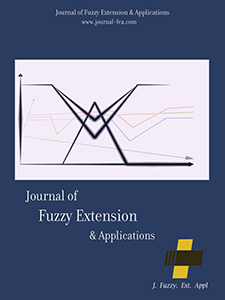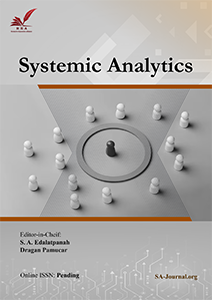Ranking Efficient DMUs in DEA based on System-Wide Performance: Directional Distance Function Approach
Keywords:
Data envelopment analysis, Efficiency, Ranking, Directional distance function, Directional slack-based measure, System-wide directional slack-based measureAbstract
In Data Envelopment Analysis (DEA), efficiency score can be a criterion for ranking inefficient Decision Making Units (DMUs). However, this criterion cannot rank efficient DMUs. This research proposes a methodology for ranking extreme and nonextreme efficient DMUs. The proposed method, based upon the influence of the individual DMUs’ performances on the system-wide performance, has many attractive properties and successfully overcomes some difficulties in ranking methods. First, a so-called Directional Slack-Based Measure (DSBM) is presented to measure system-wide performance using the directional distance function. Then, by employing this measure, a so-called system-wide DSBM is developed that is a generalization of the approach presented by Cooper et al. [22]. The main idea behind our proposed method is that the more the omission has influence (increase) on the system-wide performance, the better performance. Two illustrative examples compare the proposed method with other ranking methods.
References
Charnes, A., Cooper, W. W., & Rhodes, E. (1978). Measuring the efficiency of decision making units. European journal of operational research, 2(6), 429–444. https://doi.org/10.1016/0377-2217(78)90138-8
Sexton, T. R., Silkman, R. H., & Hogan, A. J. (1986). Data envelopment analysis: Critique and extensions. New directions for program evaluation, 1986(32), 73–105. https://doi.org/10.1002/ev.1441
Adler, N., Friedman, L., & Sinuany-Stern, Z. (2002). Review of ranking methods in the data envelopment analysis context. European journal of operational research, 140(2), 249–265. https://doi.org/10.1016/S0377-2217(02)00068-1
Cook, W. D., & Seiford, L. M. (2009). Data envelopment analysis (DEA)-thirty years on. European journal of operational research, 192(1), 1–17. https://doi.org/10.1016/j.ejor.2008.01.032
Andersen, P., & Petersen, N. C. (1993). A procedure for ranking efficient units in data envelopment analysis. Management science, 39(10), 1261–1264. https://doi.org/10.1287/mnsc.39.10.1261
Torgersen, A. M., Førsund, F. R., & Kittelsen, S. A. C. (1996). Slack-adjusted efficiency measures and ranking of efficient units. Journal of productivity analysis, 7, 379–398. https://doi.org/10.1007/BF00162048
Jahanshahloo, G. R., Lotfi, F. H., Shoja, N., Tohidi, G., & Razavyan, S. (2004). Ranking using l1-norm in data envelopment analysis. Applied mathematics and computation, 153(1), 215–224. https://doi.org/10.1016/S0096-3003(03)00625-8
Balf, F. R., Rezai, H. Z., Jahanshahloo, G. R., & Lotfi, F. H. (2012). Ranking efficient DMUs using the Tchebycheff norm. Applied mathematical modelling, 36(1), 46–56. https://doi.org/10.1016/j.apm.2010.11.077
Amirteimoori, A., Jahanshahloo, G., & Kordrostami, S. (2005). Ranking of decision making units in data envelopment analysis: A distance-based approach. Applied mathematics and computation, 171(1), 122–135. https://doi.org/10.1016/j.amc.2005.01.065
Troutt, M. D. (1995). A maximum decisional efficiency estimation principle. Management science, 41(1), 76–82. https://doi.org/10.1287/mnsc.41.1.76
Ganley, J. A., & Cubbin, J. S. (1992). Public sector efficiency measurement: Applications of data envelopment analysis. Elsevier Science Inc. https://dl.acm.org/doi/10.5555/573173
Hosseinzadeh Lotfi, F., Jahanshahloo, G. R., & Memariani, A. (2000). A method for finding common set of weights by multiple objective programming in data envelopment analysis. Southwest journal of pure and applied mathematics [electronic only], 2000(1), 44–54. https://eudml.org/doc/222875
Liu, F. H. F., & Peng, H. H. (2008). Ranking of units on the DEA frontier with common weights. Computers & operations research, 35(5), 1624–1637. https://doi.org/10.1016/j.cor.2006.09.006
Jahanshahloo, G. R., Lotfi, F. H., Rezai, H. Z., & Balf, F. R. (2005). Using Monte Carlo method for ranking efficient DMUs. Applied mathematics and computation, 162(1), 371–379. https://doi.org/10.1016/j.amc.2003.12.139
Lotfi, F. H., Fallahnejad, R., & Navidi, N. (2011). Ranking efficient units in DEA by using TOPSIS method. Applied mathematical sciences, 5(17), 805–815. https://B2n.ir/mh1784
Luenberger, D. G. (1992). Benefit functions and duality. Journal of mathematical economics, 21(5), 461–481. https://doi.org/10.1016/0304-4068(92)90035-6
Luenberger, D. G. (1995). Microeconomic theory McGraw-Hill. , Inc., New York. https://B2n.ir/nk5701
Chambers, R. G., Chung, Y., & Färe, R. (1996). Benefit and distance functions. Journal of economic theory, 70(2), 407–419. https://doi.org/10.1006/jeth.1996.0096
Chambers, R. G., Chung, Y., & Färe, R. (1998). Profit, directional distance functions, and Nerlovian efficiency. Journal of optimization theory and applications, 98, 351–364. https://doi.org/10.1023/A:1022637501082
Pastor, J. T., Ruiz, J. L., & Sirvent, I. (1999). An enhanced DEA Russell graph efficiency measure. European journal of operational research, 115(3), 596–607. https://doi.org/10.1016/S0377-2217(98)00098-8
Tone, K. (2001). A slacks-based measure of efficiency in data envelopment analysis. European journal of operational research, 130(3), 498–509. https://doi.org/10.1016/S0377-2217(99)00407-5
Cooper, W. W., Seiford, L. M., Tone, K. (2007). Data envelopment analysis: A comprehensive text with models, applications, references and DEA-solver software (Vol. 2). Springer. https://doi.org/10.1007/978-0-387-45283-8
Cooper, W. W., Huang, Z., Li, S. X., Parker, B. R., & Pastor, J. T. (2007). Efficiency aggregation with enhanced Russell measures in data envelopment analysis. Socio-economic planning sciences, 41(1), 1–21. https://doi.org/10.1016/j.seps.2006.03.001
Shephard, R. W. (1971). Theory of cost and production functions. Princeton University Press. https://B2n.ir/dr2675
Cooper, A. C. W. W., & Charnes, W. (1962). Programming with linear fractional functionals. Naval research logistics quarterly, 9(3), 181–186. https://b2n.ir/wg5765






 Metrics
Metrics